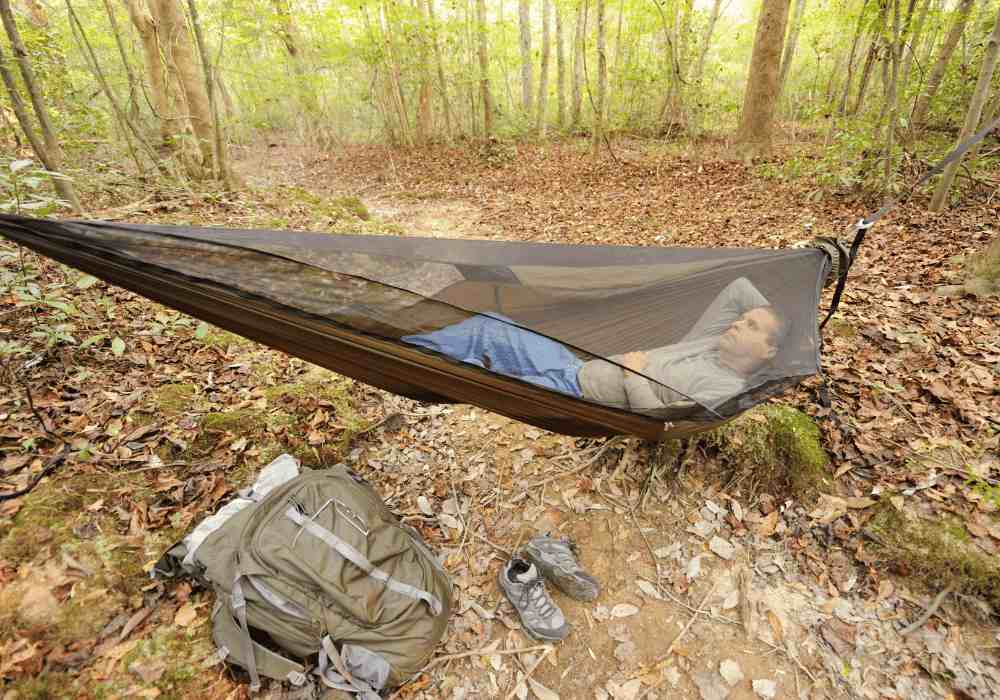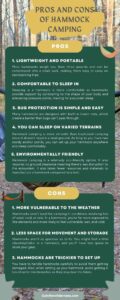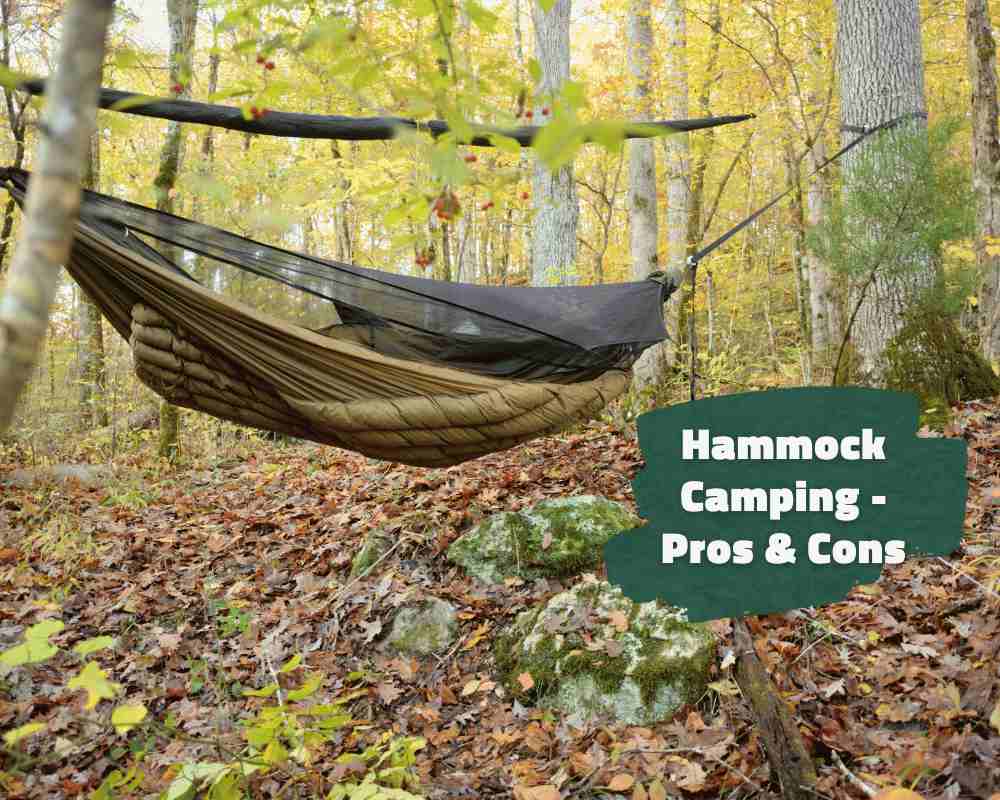Rather than setting up a tent on the ground, hammock campers hang their shelter between trees using straps and carabiners. This camping style has various pros and cons: it’s lightweight, comfortable, and versatile, but it may not always be the most practical or sensible.
In this guide, you’ll get to know the pros and cons of hammock camping in detail. That way, you can decide for yourself whether it’s the right choice for your next adventure!
The 5 Pros of Hammock Camping
1. Hammocks are lightweight and portable
One of the main advantages of hammock camping is that it’s incredibly lightweight and portable. Most hammocks weigh less than three pounds and can be compressed into a small sack, making them easy to carry on backpacking trips. As a result, you can cover more ground and explore further without being weighed down by heavy gear.
2. Hammocks are comfortable to sleep in
Many campers also report that sleeping in a hammock is more comfortable than sleeping on an air mattress or sleeping pad, or on the ground in a tent. The reason for this is that hammocks provide support by contouring to the shape of your body and alleviating pressure points, making for a sounder sleep.
3. Bug protection is simple and easy
Another reason why you’ll enjoy a great sleep in a hammock is because it can easily be turned into a bug-free environment. Many hammocks are designed with built-in insect nets, which create a barrier that bugs can’t pass through. What’s more, even if there’s no built-in net, you can always buy one and add it to your kit. Another effective barrier is a tarp.
Tip: As an alternative to bug barriers, you could bring insect repellent and store it in your hammock’s built-in pockets so that it’s easily accessible.
4. You can sleep on more varied terrains
Hammock camping is also arguably more versatile than traditional camping since it doesn’t require level ground. As long as you have two sturdy anchor points, you can set up your hammock anywhere and sleep comfortably. That means you can camp on sloping terrain or on rocky ground without needing to find a flat spot to pitch your tent.
Imagine setting up your hammock between trees, on a rocky ledge, or even over water… Hammock camping opens up a whole new world of possibilities for your trips and allows you to explore areas that might otherwise be inaccessible with traditional camping gear.
5. It’s relatively environmentally friendly
If you’re conscious about the environment, you’ll be pleased to know that hammock camping is a relatively eco-friendly option. Traditional tent camping often involves clearing a space to set up camp, which can damage the surrounding vegetation and disturb local wildlife. Meanwhile, hammocks require no clearance of ground, meaning there’s less disruption to the ecosystem.
What’s more, it takes far fewer resources and materials to manufacture a hammock compared to a tent. This arguably also makes hammocks the more sustainable choice.

The 3 Cons of Hammock Camping
1. You’re more vulnerable to the weather
Hammocks aren’t ideal for camping in conditions involving lots of wind, cold, or rain. In a hammock, you’re far more exposed to the elements and more likely to feel vulnerable, wet, and cold.
You can solve this, however! For instance, you can make the effort to find a hammock spot that’s sheltered from the wind, cold, and rain—e.g. among some dense trees. Also, if you have space in your pack, you can bring added protection and insulation with you, such as a tarp, thermal blanket, underquilt, top quilt, and sleeping pad.
Tip: Make sure to check the weather forecast before your trip so that you can prepare to bring adequate gear.
2. You have less space for movement and storage
Another drawback is that hammocks aren’t as spacious as tents. You might feel a little claustrophobic in a hammock, and you’ll have less space to store your gear. Consequently, you may have to store your gear under your hammock, which might not feel as safe.
In addition, hammocks don’t provide as much privacy as tents and may leave you feeling exposed to animals or the gaze of other people in your camping area.
3. Hammocks are trickier to set up safely
A final downside to consider is that you have to handle hammocks very carefully to avoid them getting damaged. You must take extra care when packing and unpacking your hammock so that it doesn’t rip. Also, when setting up your hammock, try to avoid getting it too close to tree branches as they may tear the fabric.
Lastly, hammocks can be unstable and flip over if not set up correctly. This can be dangerous! Again, this is avoidable, though: Just make sure you take enough time to make sure your hammock is set up correctly. Always follow the manufacturer’s instructions!

Summary
All in all, hammock camping is fun, comfy, and lightweight, and it gives you more flexibility regarding places to set up camp. It’s an excellent way to enjoy the outdoors and experience nature from a new perspective.
Admittedly, there are drawbacks to hammock camping—but these can be mitigated. You can bring extra protection to keep you sheltered from the weather, and you can take precautions to make sure your hammock is set up safely.
Although hammock camping isn’t for everyone, it is a unique and rewarding experience overall. If you’re unsure whether it’s for you, it’s certainly worth a try!
I am Bruno. Navigating the urban rush by day, I find peace under the stars by night. Alongside my loyal companion and co-adventurer Lilith, we explore the balance between city life and nature’s embrace. Through writing and films, I delve into bushcraft and the wild’s allure.
GointheWilderness is my bridge between these two realms, guiding you to reconnect with your innate wilderness.
Eden is here and now; join us in rediscovering it.

